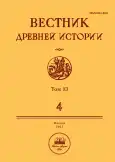Hebrew Prophecies about the Future Restoration of the Davidic Dynasty: A Folklore and Literary Tradition and Its Representation in Biblical Literature
- Autores: Bessonov I.A.1
-
Afiliações:
- Russian Biotechnological University (ROSBIOTECH)
- Edição: Volume 83, Nº 4 (2023)
- Páginas: 796-812
- Seção: Articles
- URL: https://journals.rcsi.science/0321-0391/article/view/249576
- DOI: https://doi.org/10.31857/S032103910024315-9
- ID: 249576
Texto integral
Resumo
Palavras-chave
Sobre autores
Igor Bessonov
Russian Biotechnological University (ROSBIOTECH)Russian Federation, Moscow
Bibliografia
- Albertz, R. 2001: The Social Setting of the Aramaic and Hebrew Book of Daniel. In: J.J. Collins, P.W. Flint (eds.), The Book of Daniel. Composition and Reception. Vol. I. Leiden–Boston–Köln, 171–204.
- Begg, C.T. 1986: The Significance of Jehoiachin’s Release: A New Proposal. Journal for the Study of the Old Testament 11 (36), 49–56.
- Ben Zvi, E. 2019: Reading Chronicles and Reshaping the Memory of Manasseh. In: E. Ben Zvi, Social Memory among the Literati of Yehud. Berlin–Boston, 367–386.
- Berges, U.F. 2012: The Book of Isaiah: Its Components and Final Form. Translated by M. Lind. Sheffield.
- Bewer, J.A. 1953: Textual and Exegetical Notes on the Book of Ezekiel. Journal of Biblical Literature 72/3, 158–168.
- Blenkinsopp, J. 1983: A History of Prophecy in Israel. Philadelphia.
- Collins, J.J. 1993: A Commentary on the Book of Daniel. Minneapolis.
- Coxon, P.W. 1986: The Great Tree of Daniel 4. In: J.D. Martin, P.R. Davies (eds.), A Word in a Season. Essays in Honour of William McKane. Sheffield, 91–111.
- Davies, P.R. 1976: Daniel Chapter Two. Journal of Theological Studies 27/2, 392–401.
- Duguid, I.M. 1994: Ezekiel and the Leaders of Israel. Leiden–New York–Köln.
- Foster, R.S. 1958: A Note on Ezekiel XVII 1–10 and 22–24. Vetus Testamentum 8/4, 374–379.
- Fröhlich, I. 1996: “Time and Times and Half a Time”. Historical Consciousness in the Jewish Literature of the Persian and Hellenistic Eras. Sheffield.
- Gane, R.E. 1997: The Role of Assyria in the Ancient Near East during the Reign of Manasseh. Andrews University Seminary Studies 35/1, 21–32.
- Haag, E. 1983: Die Errettung Daniels aus der Löwengrube. Untersuchungen zum Ursprung der biblischen Danieltradition. Stuttgart.
- Henze, M. 1999: The Madness of King Nebuchadnezzar: The Ancient Near Eastern Origins and Early History of Interpretation of Daniel 4. Leiden–Boston–Köln.
- Henze, M. 2016: King Manasseh of Judah in Early Judaism and Christianity. In: G.J. Brooke, A. Feldman (eds.), On Prophets, Warriors, and Kings. Former Prophets through the Eyes of Their Interpreters. Boston, 183–228.
- Japhet, S. 1985: The Historical Reliability of Chronicles: The History of the Problem and Its Place in Biblical Research. Journal for the Study of the Old Testament 10 (33), 83–107.
- Kratz, R.G. 1991: Translatio Imperii. Untersuchungen zu den aramäischen Danielerzählungen und ihrem theologiegeschichtlichen Umfeld. Neukirchen-Vluyn.
- Levenson, J.D. 1984: The Last Four Verses in Kings. Journal of Biblical Literature 103/3, 353–361.
- Lundbom, J.R. 2004: Jeremiah 21–36. A New Translation with Introduction and Commentary. New York.
- McKenzie, S.L. 2004: I & II Chronicles. Nashville.
- Murray, D.F. 2001: Of All the Years the Hopes – or Fears? Jehoiachin in Babylon (2 Kings 25 : 27–30). Journal of Biblical Literature 120/2, 245–265.
- Newsom, C.A. 2014: Daniel. A Commentary. Louisville.
- Noth, M. 1957: Zur Geschichtsauffassung des Deuteronomisten. In: A.Z. Velidi Togan (ed.), Proceedings of the Twenty-Second Congress of Orientalists, Held in Istanbul, September 15th to 22nd, 1951. Vol. II. Leiden, 558–565.
- Noth, M. 1981: The Deuteronomistic History. Sheffield.
- Odell, M.S. 2005: Ezekiel. Macon.
- Pakkala, J. 2006: Zedekiah’s Fate and the Dynastic Succession. Journal of Biblical Literature 125/3, 443–452.
- Parpola, S. 1993: The Assyrian Tree of Life: Tracing the Origin of Jewish Monotheism and Greek Philosophy. Journal of Near Eastern Studies 52/3, 161–208.
- Porteous, W.N. 1965: Daniel. A Commentary. Philadelphia.
- Pritchard, J.B. (ed.) 1992: Ancient Near Eastern Texts Relating to the Old Testament with Supplement. Princeton.
- Rad, G. von 1947: Deuteronomium-Studien. Göttingen.
- Schniedewind, W.M. 1991: The Source Citations of Manasseh: King Manasseh in History and Homily. Vetus Testamentum 41/4, 450–461.
- Soden, W. von 1935: Eine babylonische Volksüberlieferung von Nabonid in den Danielerzählungen. Zeitschrift für die Alttestamentliche Wissenschaft 53, 81–89.
- Williamson, H.G.M. 2018: Isaiah 6–12. A Critical and Exegetical Commentary. Bloomsbury.
- Wills, L.M. 1990: The Jew in the Court of the Foreign King. Minneapolis.
- Young, R.A. 2012: Hezekiah in History and Tradition. Leiden–Boston.
- Zimmerli, W. 1979: Ezekiel 1. A Commentary on the Book of the Prophet Ezekiel, Chapters 1–24. Philadelphia.
- Zimmerli, W. 1983: Ezekiel 2. A Commentary on the Book of the Prophet Ezekiel, Chapters 25–48. Philadelphia.









